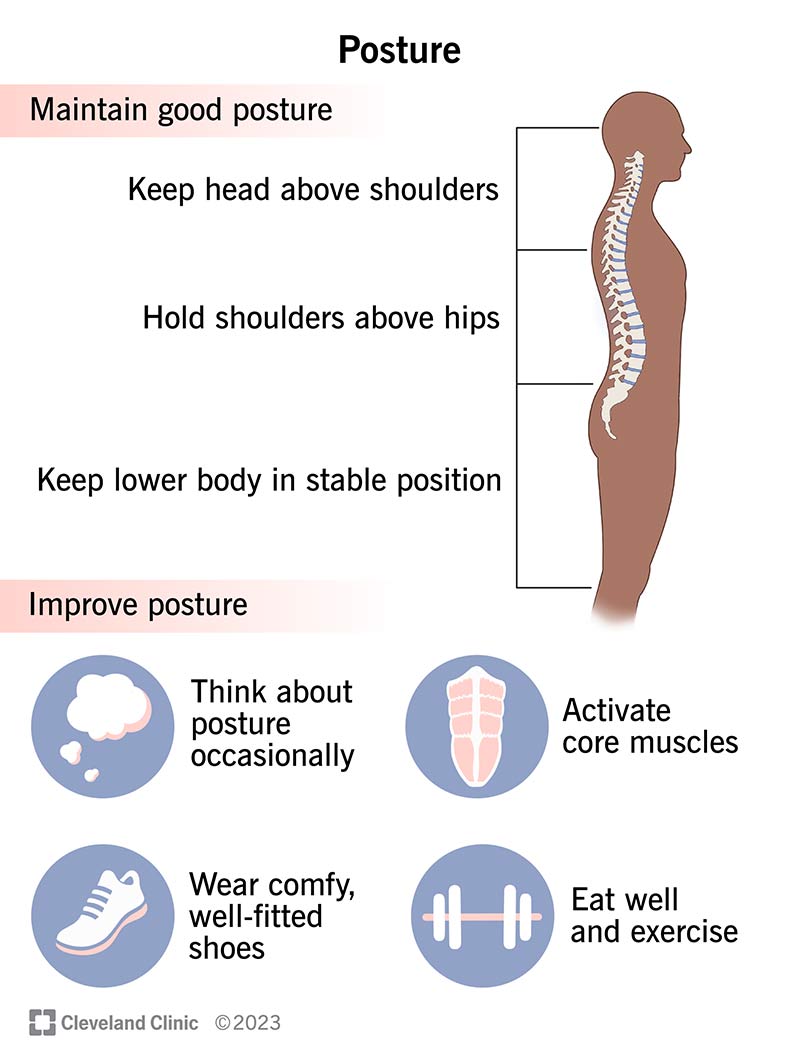Your posture is the natural way you hold your body. It’s usually an automatic adjustment that you might not notice, but being more aware of your posture throughout your day can help you support your spine better. Everyone’s posture (just like their bodies) is unique.
Advertisement
Cleveland Clinic is a non-profit academic medical center. Advertising on our site helps support our mission. We do not endorse non-Cleveland Clinic products or services. Policy

Your posture is the natural way you hold your body. It’s the position your body’s in while you’re sitting still and moving.
Advertisement
Cleveland Clinic is a non-profit academic medical center. Advertising on our site helps support our mission. We do not endorse non-Cleveland Clinic products or services. Policy
Your musculoskeletal system maintains your posture. Muscles, ligaments and tendons work with joints throughout your body to control your position at all times. They adjust your body to hold you in a stable, comfortable shape. It’s how you’re able to stay in one place when you’re not moving without sliding out of your chair.
Changes to your posture also make certain movements possible. If your body couldn’t change its shape, you’d be stuck in one position like a mannequin. Bending over to pick up a pen you dropped would be a lot harder if you had to tip your entire body onto the floor to grab it.
Everyone has a unique natural posture, but there are a few general rules you can follow to improve your posture and prevent common issues like back pain.
There are two types of posture:
Advertisement
There’s no such thing as perfect or imperfect posture. Everyone’s body is slightly different. Don’t stress about having exactly perfect posture all the time. In fact, some studies have found that commonly considered poor or bad posture has more to do with self-esteem and thinking you look good rather than staying healthy or preventing pain. What that means is, you can be mindful about sitting or moving safely, but try not to worry about it all the time.
Even if there’s not one type of posture that’s best for everyone in every situation, there are still a few general rules you can follow to support your body. The best way to maintain good posture is to protect your spine’s curves.
Your spine naturally has three curves — one in your neck (your cervical spine), the middle of your back (your thoracic spine) and in your lower back (your lumbar spine). These three curves give your spine a shape like a gently curved uppercase S. Your posture shouldn’t be bent or flexed in a way that adds extra curve to any section of your spine.
Your body controls a lot of your posture automatically, but there are a few things you can do to maintain good, healthy posture:
Having good posture can help you avoid common aches and pains in your back, neck and shoulders. Having a safe dynamic posture (especially when you’re working out or doing physical activity) can help prevent sports injuries.
Maintaining healthy posture can reduce wear and tear on your joints, especially in your spine. Good posture can’t completely prevent joint issues like arthritis, but it can reduce stress on your joints.
Following the tips above to keep your spine aligned is the best way to maintain good posture, but thinking about your posture too often can make you think it’s bad even when it’s not. There are other ways to improve your posture without constantly worrying about your spine and where it is in relation to the rest of your body.
Some simple ways to improve your posture include:
Advertisement
Having a less-than-ideal posture isn’t a health condition or disease, so it doesn’t always cause symptoms. It’s common to have back pain, headaches or feel stiff if you’ve been in one position for a long time without moving. You can prevent some of these issues by improving your posture and staying active, but your posture doesn’t always cause them.
Lots of people feel guilty about not having perfect posture. But studies have found that posture might not directly cause pain as much as many people think. It’s likely that having poor posture is only one factor that leads to pain and other symptoms. Not stretching or being physically active also combine to cause these issues, probably more than just your posture on its own.
Your posture can lead to symptoms like back pain and headaches, especially if you spend a long time in one position. Posture can affect:
Visit a healthcare provider if you’re experiencing pain that doesn’t get better on its own in a few weeks. Even if it’s not directly caused by your posture, a provider should examine any new pain, especially if it doesn’t go away or gets worse.
Advertisement
If you’re like most people, you might spend a lot of time worrying that you’re not sitting up straight enough, or that your posture is going to cause all sorts of pain and other issues. While it’s true that your posture (how you hold your body) is important to your health, a weekend of slouching down in your chair to binge your favorite TV show isn’t going to wreck your back.
It’s always a good idea to be aware of your posture throughout the day — especially if you sit at a desk or stand on your feet for long periods. Take a break, stretch and change positions. Visit a healthcare provider if you’re experiencing neck, shoulder or back pain. They’ll help you understand what’s causing your symptoms and what you can do to relieve them.
Advertisement
Last reviewed on 10/18/2023.
Learn more about the Health Library and our editorial process.